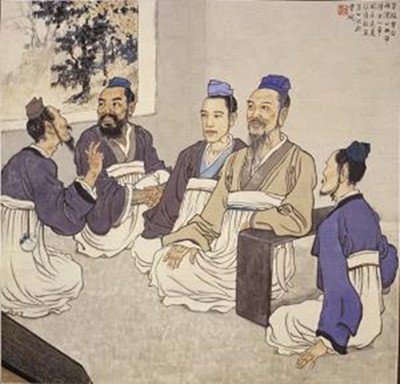
当前课程知识点:Culture and Tourism > Week 1: Cultural Tourism: Definitions and Concepts > 1.2 Cultural Heritage-1 > 1.2.2 Criterion(i): masterpiece of human creative genius
返回《Culture and Tourism》慕课在线视频课程列表
返回《Culture and Tourism》慕课在线视频列表
在这一节中,我将讨论标准一。
我将举几个例子来说明什么地方可以参考这一标准。
因此,评判标准一是人类创造的天才般杰作。
这是什么意思呢?
换句话说,这个标准与一个杰出的例子有关,
也许是一个风格在文化中发展的顶峰或里程碑式的例子,
一个高智商或象征天赋; 高水平的艺术、
技术或工艺水平
唯一性本身并不足以证明题字的合理性。
其属性必须在更广阔的文化历史背景下考虑,
以及它的价值必须放在在标准和环境中评估。
《世界遗产名录》是一份财产清单,而不是人的清单。
例如,在标准(i)下,需要的是
人类创造性天才的杰作。
《世界遗产名录》没有列出天才,但可以列出他们的杰作。
同样地,它也不会列出一个天才的作品主体,
但它可以列出具有突出的普遍价值的杰作,
或者是作为一个整体具有突出的普遍价值的一系列杰作。
我给大家举几个例子。
第一个是悉尼歌剧院。
每个人都必须知道它。
我还记得,它在2000年的悉尼奥运会的样子。
很漂亮,对吧?
2017年被列入《世界遗产名录》的悉尼歌剧院
是20世纪伟大的建筑作品,
在建筑形式和结构设计上
汇集了多种创意和创新。
这座伟大的城市雕塑坐落在一处引人注目的水景之中,
它位于一个半岛的顶端,伸入悉尼港,
至今仍对建筑产生着持久的影响。
悉尼歌剧院由三组相互连接的
拱形“贝壳”组成,它们覆盖了两个主要的表演大厅
和一个餐厅。
这些贝壳结构被设置在一个巨大的平台上,
并被作为步行街的平台区域所包围。
I1957年,悉尼歌剧院的项目由国际陪审团授予
丹麦建筑师Jørn Utzon,
它标志着一个全新的施工方法。
那么,写这些东西的标准理由是什么呢?
悉尼歌剧院是20世纪伟大的建筑作品。
它代表了多重创造力,
尤其是在建筑形式和结构设计方面,
一个精心设置在著名水景
和世界著名标志性建筑中的伟大城市雕塑。
1955年9月13日,卡希尔发起了一项国际设计竞赛,
233份参赛作品
来自32个国家,赢家是丹麦建筑师Jørn Utzon。
设计过程非常有趣。
Jørn Utzon基于悉尼歌剧院赢得了普利兹克建筑奖,
这是建筑界的最高荣誉,在2003年,普利兹克奖的颁奖词是:
毫无疑问,悉尼歌剧院是他的杰作。
It is one of the great iconic buildings of the 20th century,
它是20世纪最伟大的标志性建筑之一,
是一幅举世闻名的美丽图画,不仅是一座城市的象征,也是整个国家和大陆的象征。
你知道,建造悉尼歌剧院有几个阶段,
非常复杂。
第一阶段是从1959年到1963年,由建筑的上层平台,
和第二阶段的建筑外壳;
第三阶段室内设计与施工。
嗯,1957年最初的成本
进度预算是350万英镑(700万美元),完工日期是1963年1月26日(澳大利亚日)。
实际上,该项目在1973年晚些时候完成,
比预算超出了10倍多,实际预算为1.02亿美元。
我要讲的另一个例子,也是一部关于安东尼·高迪作品的杰作。
你应该知道,至少所有的架构由安东尼·高迪设计的,
但这样的代表建筑的教堂,
圣家堂,在巴塞罗那是非常巨大的,
七个属性由架构师安东尼·高迪在或接近巴塞罗那
见证了高迪非凡的创造性贡献的建筑和建筑技术的发展
在19世纪末和20世纪初建造的。
这些纪念物代表了一种兼收并蓄的个人风格,
在花园、雕塑和所有装饰艺术以及建筑的设计中被赋予了自由的主导权。
七座建筑分别是:帕克·格尔;米拉之家;
圣家堂;巴特罗之家;
这四样东西都列在巴塞罗那。
这一些细节的东西像圣家堂,
和圣家堂作证“高迪的杰出的创造性
贡献建筑和建筑技术的发展”,
“有代表加泰罗尼亚”和
“预期和影响的许多形式和技术相关的现代建筑
在20世纪的发展”。
这座建筑的设计本身就有两极化的趋势。
高迪的同行建筑师的评价普遍是积极的;
比如路易·苏利文(Louis Sullivan)就非常赞赏它,称圣家堂
是“过去25年里最伟大的创意建筑”。
它是用石头象征的精神!沃尔特·格罗皮乌斯也赞扬了
圣家堂,称建筑的墙壁
是“技术完美的奇迹”。
《时代》杂志也称其为“感性的、精神的、异想天开的、优秀的”
你可以从这些图片中看到,它是高迪建造的模型,
像其他建筑,你知道,从上到下。
抱歉,从下到上。
但是从上到下的构建,是非常特别的。
这两个是帕克·格尔;米拉之家
它也代表了高迪设计的伟大作品。
这是在标准一下的一系列提名。
在接下来的课程中,我还会讲到一系列的标准。
这两幅图展示了巴特洛之家的另一个例子,
这也是高迪的代表作之一。
你知道,一个伟大的画家达利称
高迪的作品就像上帝一样。
他们可以很好地利用曲线。
达利认为,一些研究认为,直线属于人类,
曲线属于上帝。
但是你知道,高迪可以用上帝的语言来建造这些奇妙的建筑。
真是天才般的杰作。
我想讲的第三个例子是著名的泰姬陵。
泰姬陵是巨大的白色大理石陵墓,
建于1631年和1648年之间的阿格拉的莫卧儿王朝皇帝沙贾汗
为纪念他最喜欢的妻子,
在印度,泰姬陵是穆斯林的珠宝艺术
也是世界普遍推崇的一个杰作的遗产。
你知道,泰姬陵的标准之一是通过完美的
和谐和优秀的工艺
在整个印度伊斯兰雕塑建筑中代表了最好的建筑和艺术成就。
它是构思、处理和执行的建筑风格的杰作,
在平衡、对称和各种元素的和谐融合方面
具有独特的审美品质。
你无法想象泰姬陵有多精致,
它的视觉方向是45度,而且设计得那么好。
泰姬陵是如此的杰作代表。
所以在这一部分,我将讨论标准一,并给出三个例子,
泰姬陵,高迪的作品和悉尼歌剧院。
下一节,我将讨论准则二。
谢谢大家。
-1.1 Introduction course outline and UNESCO World Heritage Program
--1.1.1 Introduction of culture and tourism course outline
--1.1.2 Introduction of UNESCO World Heritage Program(1)
--1.1.3 Introduction of UNESCO World Heritage Program(2)
-1.2 Cultural Heritage-1
--1.2.1 The meaning of culture heritage
--1.2.2 Criterion(i): masterpiece of human creative genius
--1.2.3 Criterion(ii): exhibit important interchange of human value
--1.2.4 Criterion(iii): bear a unique or at least exceptional testimony
--How can the public understand the importance of heritage?
-1.3 Cultural Heritage-2
--1.3.1 Criterion(iv): an outstanding example in human history
--1.3.2 Criterion(v): represent a culture or human interaction with environment
--1.3.3 Criterion(vi): associated with living traditions of outstanding universal significance
-1.4 Natural Heritage
--1.4.1 Natural heritage features, formations and criterions
--1.4.2 Cases studies of natural heritage
--Cultural landscape meanings: The case of West Lake, Hangzhou, China
--How to access heritage of your hometown?
-2.1 Mixed Culture and Natural Heritage
--2.1.1 Mixed heritage operational guidelines and cases (1)
--2.1.2 Mixed heritage operational guidelines and cases (2)
--2.1.3 Mixed heritage operational guidelines and cases(3)
-2.2 Authenticity, Integrity and Cultural Routes
--2.2.1 How to determine authenticity and integrity
--2.2.2 Heritage routes and heritage canals (1)
--2.2.3 Heritage routes and heritage canals (2)
--What do you think about cultural heritage categories?
-2.3 Special Heritage and Sustainable
--2.3.1 Physical remains of the history of technology and industry
--2.3.2 Transboundary Heritage, Serial Heritage, Serial/Transnational Heritage
--2.3.3 Intangible cultural heritage
--2.3.4 UNESCO World Heritage and Sustainable Tourism Programme
--Recovering the Memory of Ourselves for the Sustainable Cites
--Week 2 quiz
--What do you think about cultural heritage categories?
-3.1 The Australia’s Heritage System and Sydney Opera House
--3.1.1 The Australian Heritage System
--3.1.2 Case Study: The Sydney Opera House
-3.2 Role of the ISCCL and Cultural Landscape (1)
--3.2.2 Uluru-Kata Tjuta National Park
--3.2.3 Honghe Hani Rice Terraces
-3.3 Role of the ISCCL and Cultural Landscape (2)
--3.3.1 West Lake cultural landscape (1)
--3.3.2 West Lake cultural landscape (2)
-3.4 Rural Landscapes as Heritage
--3.4.1 ISCCL Principles Concerning Rural Landscapes as Heritage
-3.5 Case Study: Mongolian Altai
--3.5.1 Nature Culture Integration & the Mongolian Altai(1)
--3.5.2 Nature Culture Integration & the Mongolian Altai(2)
--Week 3 quiz
--Discussion: What do you think is the role of ISCCL?
-4.1 Introduction of the Meaning of 'landscape’
--4.1.1 Brief introduction of landscape and culture
--4.1.2 The conceptual framework of cultural landscape
-4.2 Landscape Values
--4.2.1 The word “landscape” itself and differences in Western, Eastern
--4.2.2 Cultural significance for heritage source
--Discussion: What do you think the cultural landscape attracts you?
-4.3 Reading the Landscape: Identification and Assessment
--4.3.1 Planning model for heritage conservation management policy
--4.3.2 Cultural landscape resources evaluation steps
--Article: Cultural mapping: Intangible values and engaging with communities with some reference to As
-4.4 Case Study: Wingecarribee Historic Landscape
--4.4.1 Case study:Wingecarribee historic landscape study(1)
--4.4.2 Case study:Wingecarribee historic landscape study(2)
--Week 4 quiz
--Discussion: What should we do to strengthen the protection of cultural landscape?
-5.1 Indigenous Tourism
--5.1.1 Indigenous tourism background
--5.1.2 World heritage and indigenous peoples
--5.1.3 Tourism issues at Canadian indigenous world heritage sites
--Discussion: What challenges indigenous World Heritage faces?
--Article: State conceptions of indigenous tourism in Chile
-5.2 Case Study and Conclusion: Great Expectations for Tourism
--5.2.1 Case study Pimachiowin Aki
--5.2.2 Conclusions:Great Expectations for Tourism
--Disussion: Do you have any experience of indigenous tourism?
--Week 5 quiz
-6.1 The Definition of Heritage in Heritage Performance Study
--6.1.1 The definition of heritage in heritage performance study
--6.1.2 Heritage performance and meaning making
--6.1.3 Two key issues emerging from qualitative study
-6.2 Heritage Performance - Evidence from Australia, England and USA
--6.2.1 Heritage performance - reinforcement
--6.2.2 Heritage Performance - inter-generational communication and social values
--6.2.3 Heritage performance - recognition and respect
--6.2.4 Heritage performance - education
--Article:Theorizing museum and heritage visiting
-6.3 The Conclusion of Heritage Performance
--6.3 The conclusion of heritage performance
--Week 6 quiz
--Discussion: What kinds of heritage performances have you learned in this week?


